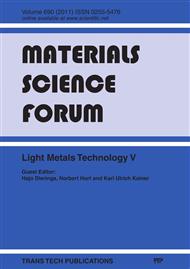p.29
p.33
p.37
p.41
p.45
p.49
p.53
p.57
p.61
A Study of the Influence of Strain Hardening and Precipitation Hardening Sequence on Development of Mechanical Properties of AlMgSi Conductor Alloys
Abstract:
The paper focuses on 6xxx series AlMgSi conductor alloys. Such alloys are used for manufacturing of conductors for power transmission. Since the most current standards define as many as seven types of wires with various mechanical and electrical specifications, the existing philosophy of AlMgSi wires manufacturing technology for electrical applications has to be revised. Strength specifications of precipitation hardened AlMgSi alloys may be enhanced by strain and by precipitation hardening. Therefore from the scientific point of view identification seems to be relevant of the impact of the sequence of these mechanisms on development of final wire properties. In particular, this paper tries to answer the following question: Does the sequence of hardening mechanisms affect the development of mechanical properties of AlMgSi alloy wires The paper presents results of a study of the impact of artificial ageing parameters of 6201 grade AlMgSi alloy wires on their final properties. The study results are presented and discussed in two parts. The first part addresses the impact of artificial aging temperature and duration on the strength properties of AlMgSi (grade 6201) alloy wire rod. The second part is focused on hardening development in the process of drawing of a AlMgSi wire made of the same alloy grade, subjected to different thermal treatments, the parameters of which have been selected based on analysis of the results of the first, wire-rod related, part of the study.
Info:
Periodical:
Pages:
45-48
Citation:
Online since:
June 2011
Authors:
Keywords:
Price:
Сopyright:
© 2011 Trans Tech Publications Ltd. All Rights Reserved
Share:
Citation:


